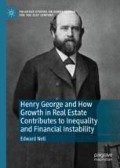Abstract
George understood “progress”—economic growth—to be disruptive and innovative, taking place through developments that changed the proportions and relative prosperity of different sectors. He began his analysis with the movement of settlers to the “unbounded savannah,” where they cultivated fertile land, cooperated and established the division of labor, increasing productivity, and, as a result, they became a complex society with differential advantages and disadvantages to certain locations and parcels of land. Rents thus emerged (modeled using Sraffa’s equations). This picture is a good basis on which to build an approach to inequality and instability, but it is not consistent with the factor markets of conventional marginal productivity theory. George’s approach is superior.
The rent of land is determined by the excess of its produce over that which the same application can secure from the least productive land in use.
—Henry George
Access this chapter
Tax calculation will be finalised at checkout
Purchases are for personal use only
Notes
- 1.
See Sraffa (1960), chap. 11.
- 2.
I have argued elsewhere that this is a mistake and can be avoided, but requires a serious change in how we think about labor (Nell 2017).
- 3.
Divide the first equation in the text by A, the second by B, and so on; the result will be the equation in its more usual form.
- 4.
- 5.
- 6.
- 7.
Not altogether wrong if the level of aggregate demand is low; higher wages will lead to higher household spending which will increase revenues. But this is not what George meant.
Bibliography
Alchian, Armen. (1950) “Uncertainty, Evolution and Economic Theory.” Journal of Political Economy (58): 211–21.
Andrews, P W S (1949) Manufacturing Business. London: Macmillan.
Bryson, Philip J. (2011) The Economics of Henry George: History’s Rehabilitation of America’s Greatest Early Economist. New York: Palgrave Macmillan.
Garegnani, Pierangelo. (1970) “Heterogeneous Capital, the Production Function, and the Theory of Distribution,” Review of Economic Studies, 73(3) 407–36.
George, Henry. (1915) Progress and Poverty. Garden City: Doubleday.
Hall, R, and Hitch, C. J. (1939) “Price Theory and Business Behavior,” Oxford Economic Papers, 2: 12–45.
Harcourt, G. C. (1972) Some Cambridge Controversies in the Theory of Capital. Cambridge: Cambridge University Press.
Kurz, Heinz. (1990) Capital, Distribution and Effective Demand. Cambridge: Polity Press and Basil Blackwell.
Kurz, Heinz, and Neri Salvadori. (1993) “The ‘Standard Commodity’ and Ricardo’s Search for an ‘Invariable Measure of Value.’” In The Dynamics of the Wealth of Nations, edited by Mauro Baranzini and G. C. Harcourt. London: Macmillan.
H Kurz and N Salvadori, 1995, THEORY OF PRODUCTION:A Long Period Analysis; Cambridge, UK: Cambridge University Press.
Laibman, David, and Edward J. Nell. (1977) “Reswitching, Wicksell Effects, and the Neoclassical Production Function.” American Economic Review (63): 100–13.
E. J Nell, ed. 1980. GROWTH, PROFITS AND PROPERTY, Cambridge UK: CambridgeUniversity Press.
Nell, E J. (1998a) The General Theory of Transformational Growth: Keynes after Sraffa. Cambridge: Cambridge University Press.
Nell, E J, ed. (1998b) Transformational Growth and the Business Cycle. London: Routledge.
Nell, E J. (2017) “Unemployment and Transformational Growth in the Long Run,” in M Foster, and M Murray, eds., Full Employment and Social Justice: Solidarity and Sustainability, Berlin: Springer.
Nell, E J and Errouaki, K. (2013) Rational Econometric Man. Cheltenham: Edward Elgar.
Petri, Fabio. (1982) “The Patinkin Controversy Revisited.” Quademi dell Instituto di Economia, no. 15.
Ricardo, David. (1951) Principles of Political Economy and Taxation. Vol. 1 of The Works and Correspondence of David Ricardo, edited by Piero Sraffa. Cambridge: Cambridge University Press.
Schefold, Bertram. (1997) Normal Prices, Technical Change and Acculmulation, London: Macmillan.
Sraffa, Piero. (1960) Production of Commodities by Means of Commodities. Cambridge: Cambridge University Press.
Turner, Adair. (2014) “The Consequences of Money-Manger Capitalism,” Oct. 4, YouTube.com.
Author information
Authors and Affiliations
Rights and permissions
Copyright information
© 2019 The Author(s)
About this chapter
Cite this chapter
Nell, E. (2019). Understanding Rents in the Real Economy. In: Henry George and How Growth in Real Estate Contributes to Inequality and Financial Instability . Palgrave Studies on Henry George for the 21st Century. Palgrave Pivot, Cham. https://doi.org/10.1007/978-3-030-18663-0_2
Download citation
DOI: https://doi.org/10.1007/978-3-030-18663-0_2
Published:
Publisher Name: Palgrave Pivot, Cham
Print ISBN: 978-3-030-18662-3
Online ISBN: 978-3-030-18663-0
eBook Packages: Economics and FinanceEconomics and Finance (R0)

